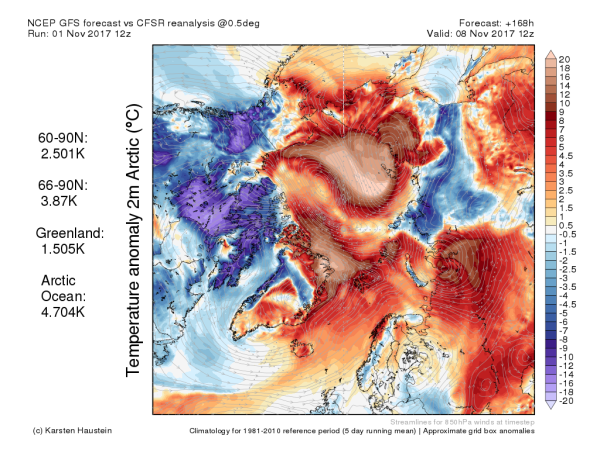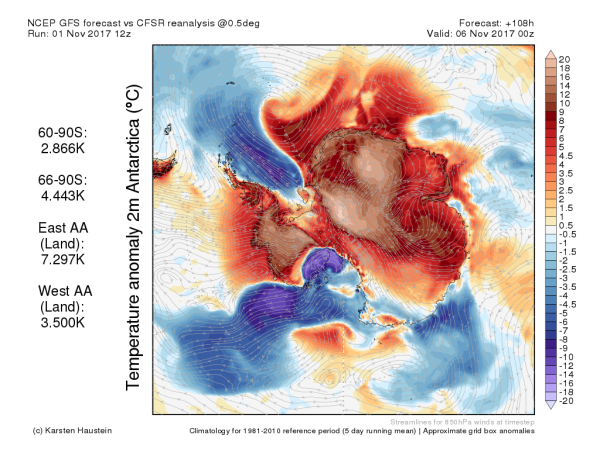If
you can sleep well after reading the following I would regard you as
being dim-witted or insensitive.
Extreme Warming at the Poles this Week — Arctic and Antarctic Temperatures to Rise to 20-30 C Above Average in Some Locations
1
November, 2017
Human-caused
climate change via fossil fuel burning produces a number of stranger
things. And some of the weirdest happen to occur in the polar regions
of our world.
One
of the foremost of these odd impacts is called polar
amplification. Under
polar amplification, the warming effects of elevated greenhouse
gasses are concentrated at the poles. This is due to reduced
reflectivity (albedo) from smaller snow and sea ice concentrations,
due to the increased intensity of the greenhouse effect in colder and
darker regions, and due to increased energy transfer from lower
latitudes into upper latitudes due to weakening of the polar Jet
Stream.
Over
the next week, this kind of polar amplification is predicted to
generate very extreme warm temperatures for both poles of our world.
(Warm
winds blowing into the Arctic will produce far above average
temperatures this week. Image source: Global
and Regional Climate Anomalies.)
In
the Arctic, temperatures in both Northern Greenland and on the
Siberian side of the Arctic Ocean are predicted to hit ranges higher
than 20 degrees Celsius above average (36 degrees Fahrenheit) with
some readings over Northeastern Siberia striking near the 30 C above
average mark by early next week (54
degrees F). This will produce near or above freezing temperatures
over both Siberia and sections of the Arctic Ocean above the 80
degree North Latitude line. Overall, temperatures are predicted to
average as high as 4.4
C above average for the entire Arctic.
A very considerable warm temperature departure consistent with the
heightened levels of global warming the world has been experiencing
during recent years.
In
the Antarctic, where temperature variance should be moderating as
austral spring shifts toward summer, the exact opposite is occurring.
Very warm temperatures hitting more than20
C above average are expected to sweep across East Antarctica this
week and ultimately cross over to West Antarctica. Above
freezing or near freezing temperatures in some coastal
regions including
coastal West Antarctica and over the Amery Ice Shelf in East
Antarctica will accompany far warmer than normal, but still below
freezing, temperatures inland.
(Even
as the Arctic is predicted to heat up, the Antarctic is also expected
to experience much warmer than normal conditions. Image
source: Global
and Regional Climate Anomalies.)
Overall
temperatures for East Antarctic land masses will hit an
amazing 7 C above averageeven
as temperatures
for West Antarctic land masses rise to 5.1 C above average for
later this week.
Primary
atmospheric drivers for these warming events are
large synoptic warm wind patterns drawing
above average temperatures into both the Arctic and Antarctic. In the
Arctic, winds crossing hundreds of miles of warm Pacific Ocean in
association with the back side of a high pressure system moving over
the Bering Sea will draw these very warm temperatures northward. In
the Antarctic, warm winds funneling southward from Australia will
reinforce the influence of a
strong high pressure dome over East Antarctica even
as another strong synoptic warm wind pattern feeds into West
Antarctica off the Pacific and Southern Oceans later in the week.
It’s
very early for temperatures over parts of Antarctica to be pushing
above freezing. And it’s rather late for such similar temperatures
to be continuing to invade so far north into the Arctic. So much
warmth will have an ongoing deleterious impact to both sea and land
ice as well as snow cover. Contributing to the overall pattern of
warming and melt we’ve seen for both Antarctica and the Arctic
during recent years as global temperatures have risen into a range
from 1 C to 1.2 C above 1880s averages.
Links:





No comments:
Post a Comment
Note: only a member of this blog may post a comment.